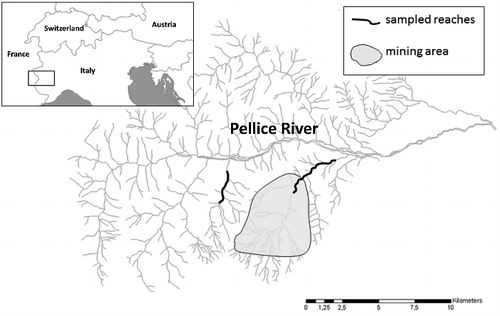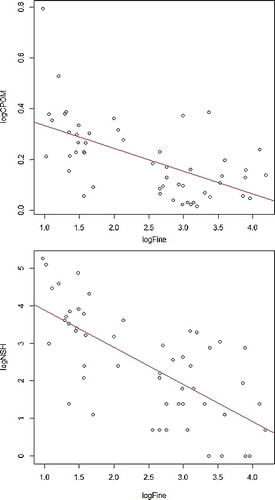Abstract
Fine sedimentation was quantified in the upper stretch of the Pellice river basin (Italian Alps), in an area partially disturbed by mining activities. Sediment traps were placed in 52 sites and benthic samples were collected to assess the amount of coarse particulate organic matter and the structure of macroinvertebrate community. The results indicated that the increase of fine sediment in the river reduced the amount of coarse particulate organic matter, affecting the abundance of invertebrate shredders. In small alpine streams, where allochthonous organic matter is the main energy source, fine sedimentation reduces the availability of trophic resources, affecting the abundance of benthic communities.
The increase of fine sediments has become a key problem in many rivers (Weigelhofer & Waringer Citation2003), particularly in mountain lotic systems which are characterised by coarse substrata because of high flow velocities and great tractive forces (Bona et al. Citation2008). Fine sedimentation affects benthic organisms directly (i.e., damaging soft body parts or decreasing habitat availability; Bo et al. Citation2007) and indirectly (i.e., altering trophic resources), with detrimental effects on invertebrate filterers (Jones et al. Citation2012) and scrapers (Kreutzweiser et al. Citation2005). In mountainous, low-order lotic systems, the main energy source is represented by allochthonous organic matter, mainly terrestrial leaves (Tank et al. Citation2010; Bo et al. Citation2014). In such environments, storage and availability of benthic coarse particulate organic matter (CPOM) is influenced by a wide range of processes. Recent studies emphasised the importance of typology and abundance of in-stream structures in trapping and retaining allochthonous materials (Jones Citation1997; Small et al. Citation2008).
Little information is available about the impact of fine sediments on the retention of allochthonous organic materials in Alpine streams and its ecological effect on shredders (i.e., benthic invertebrates that feed on this resource). In this study, fine sedimentation was quantified using sediment traps, designed according to Bond (Citation2002). The traps were randomly deployed in 52 spots in the upper part of the Pellice river basin (Italian Alps, ), in an area partially disturbed by mining activities (Sandrone et al. Citation2004). The traps were placed on 28 June 2013 and removed 17 days later. Sediment that was collected in the traps was returned to the laboratory, dried and sieved. Several studies have examined the effect of sediment grain size (Wood & Armitage Citation1997; Kreutzweiser et al. Citation2005); in this study, only the <0.105 mm fraction, belonging to ‘very fine sand’ in the Wentworth grain size classification, was considered (hereinafter, fine sediment). We selected this fraction because its occurrence is expected to be more ‘unnatural’ and related to mining activity in Alpine environments. On the removal date, one benthic sample was collected in each point to quantify CPOM and macroinvertebrate community, using a Surber sampler (250 μm mesh size; 0.062 m2 area). The sampler was placed in the section of streambed immediately after the removal of sediment traps, close (laterally) to trap sites. The traps collected a wide- ranging amount of fine sediment, ranging from a minimum of 1.64 g to a maximum of 64.7 g. Mean mass of the trapped fine sediment was 16.9 g (±2.27 SE). Also, benthic CPOM showed a high variability, ranging from 0.27 to 19.5 g/m2 with a mean of 3.86 g/m2 (±0.46 SE). In total, we collected 13,528 macroinvertebrates. Mean abundance in the substratum was 4196 organisms/m2 (±451.5 SE). Regarding the functional composition of the invertebrate assemblages, collectors–gatherers were the most represented functional feeding group (75.1%), followed by shredders (10.3%), predators (8.4%), scrapers (4.9%) and filterers (1.3%). The relative proportion of shredders showed a high variance, ranging from a maximum of 18.5% to total absence. Three species of Plecoptera:Euholognatha, Protonemura sp., Leuctra sp. and Nemoura sp., followed by Diptera: Tipulidae Prionocera sp. constituted the most abundant shredder taxa. Analysis of the relationship between fine sediment and CPOM amounts and shredder abundance was performed with log-transformed data. Trapped fine sediment was significantly related to CPOM amount (t = −5.099, r = −0.58, p < 0.001) and to shredder abundance (t = −6.685, I = −0.69, p < 0.001, ).
Figure 1. River Pellice basin and study area; black lines indicate sampled reaches and the grey zone indicates mining area.

Figure 2. Relationship between fine sediment amounts and CPOM availability (above) and invertebrate shredder abundance (below).

The presence of large mining areas and related intense road traffic in the sampled watershed resulted in an increase in fine sediment accumulation into the streambed. This massive amount of fine sediment homogenised the substrate, occluding the gaps, and reducing morphological diversity and presence of elements that can trap and retain coarse organic particles. In the most impacted sites, we observed that stream boulders, small woody debris and riverbanks were covered with a thick patina which probably diminished their effectiveness as retention structures. The results suggested that the increase of fine sediments in the river bottom directly reduced the amounts of CPOM, affecting the abundance of invertebrate shredders. Alpine lotic systems are facing increasing challenges because of local increases in human activities (Wohl Citation2006) and global effects of climate change (Fochetti Citation2012). In these environments, where allochthonous organic matter represents the main energetic source, fine sedimentation constitutes an important factor that reduces biodiversity and abundance of benthic communities.
Acknowledgements
This work was supported by the University of Piemonte Orientale Parco del Po-S. Fenoglio and University of Torino “Ricerca Locale 60% 2014 - F. Bona grants
Disclosure statement
No potential conflict of interest was reported by the authors.
References
- Bo T, Cammarata M, López-Rodríguez MJ, Tierno de Figueroa JM, Baltieri M, Varese P, Fenoglio S. 2014. The influence of water quality and macroinvertebrate colonization on the breakdown process of native and exotic leaf types in sub-alpine stream. J Freshw Ecol. 29:159–169.
- Bo T, Fenoglio S, Malacarne G, Pessino M, Sgariboldi F. 2007. Effects of clogging on stream macroinvertebrates: an experimental approach. Limnologica. 37:186–192.
- Bona F, Falasco E, Fenoglio S, Iorio L, Badino G. 2008. Response of macroinvertebrate and diatom communities to human‐induced physical alteration in mountain streams. River Res Appl. 24:1068–1081.
- Bond NR. 2002. A simple device for estimating rates of fine sediment transport along the bed of shallow streams. Hydrobiologia. 468:155–161.
- Fochetti R. 2012. Italian freshwater biodiversity: status, threats and hints for its conservation. Ital J Zool. 79:2–8.
- Jones JB. 1997. Benthic organic matter storage in streams: influence of detrital import and export, retention mechanisms, and climate. J North Am Benthol Soc. 16:109–119.
- Jones JI, Murphy JF, Collins AL, Sear DA, Naden PS, Armitage PD. 2012. The impact of fine sediment on macroinvertebrates. River Res Appl. 8:1055–1071.
- Kreutzweiser DP, Capell SS, Good KP. 2005. Effects of fine sediment inputs from a logging road on stream insect communities: a large‐scale experimental approach in a Canadian headwater stream. Aquat Ecol. 39:55–66.
- Sandrone R, Colombo A, Fiora L, Fornaro M, Lovera E, Tunesi A, Cavallo A. 2004. Contemporary natural stones from the Italian western Alps (Piedmont and Aosta Valley regions). Period Miner. 73:211–226.
- Small MJ, Doyle MW, Fuller RL, Manners RB. 2008. Hydrologic versus geomorphic limitation on CPOM storage in stream ecosystems. Freshw Biol. 53:1618–1631.
- Tank JL, Rosi-Marshall EJ, Griffiths NA, Entrekin SA, Stephen ML. 2010. A review of allochthonous organic matter dynamics and metabolism in streams. J North Am Benthol Soc. 29:118–146.
- Weigelhofer G, Waringer J. 2003. Vertical distribution of benthic macroinvertebrates in riffles versus deep runs with differing contents of fine sediments (Weidlingbach, Austria). Int Rev Hydrobiol. 88:304–313.
- Wohl E. 2006. Human impacts to mountain streams. Geomorphology. 79:217–248.
- Wood PJ, Armitage PD. 1997. Biological effects of fine sediment in the lotic environment. Environ Manage. 21:203–217.
